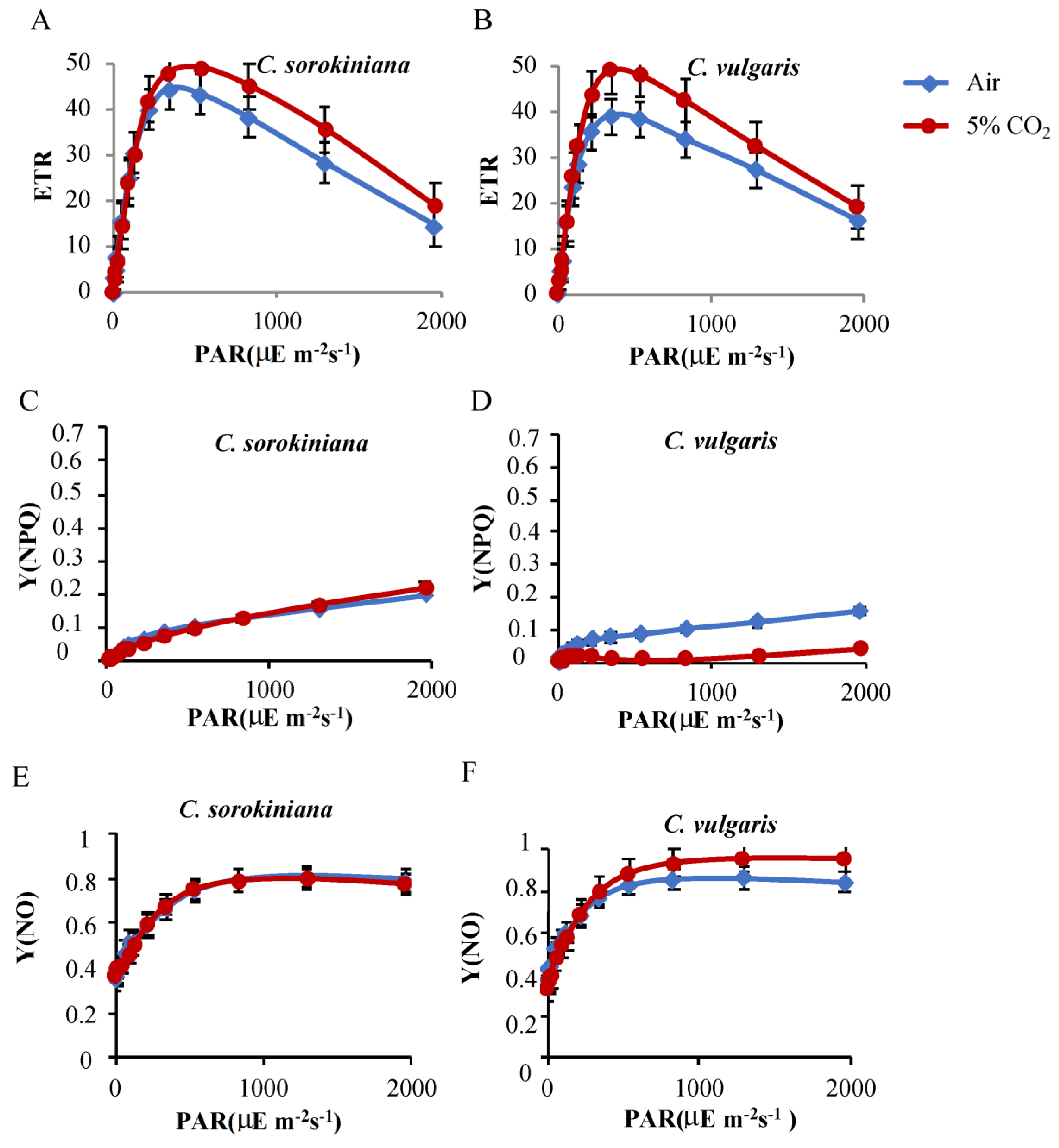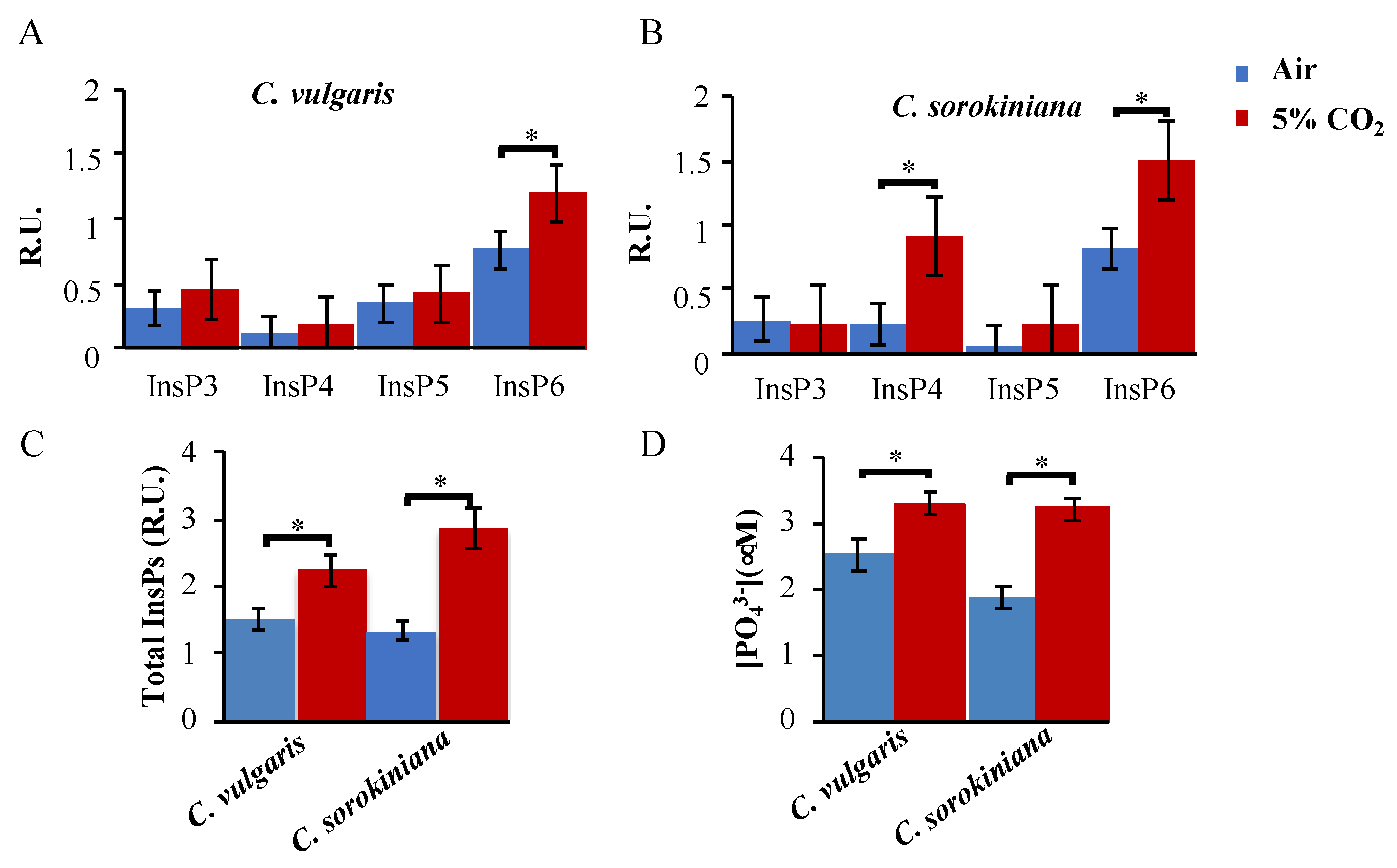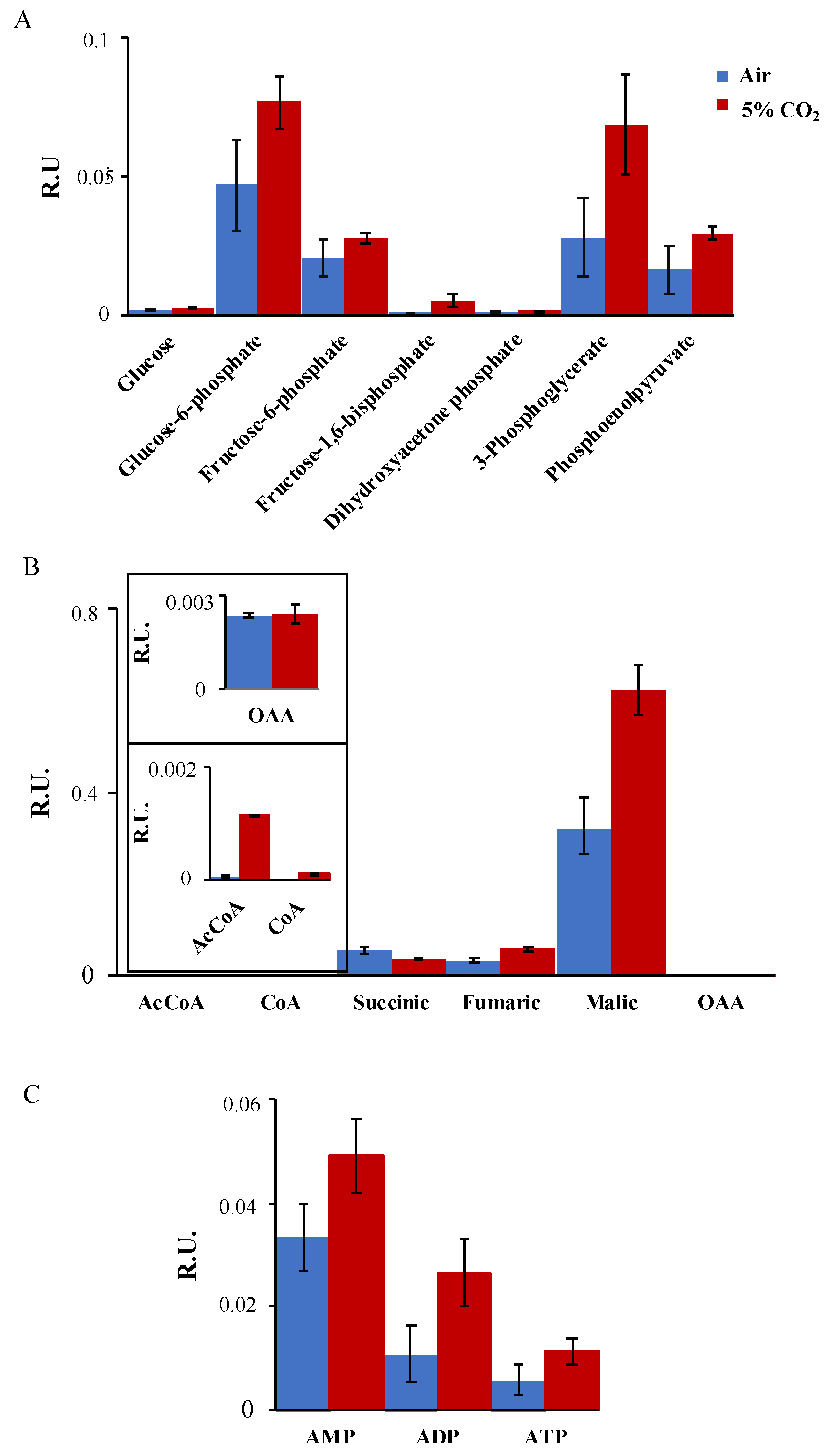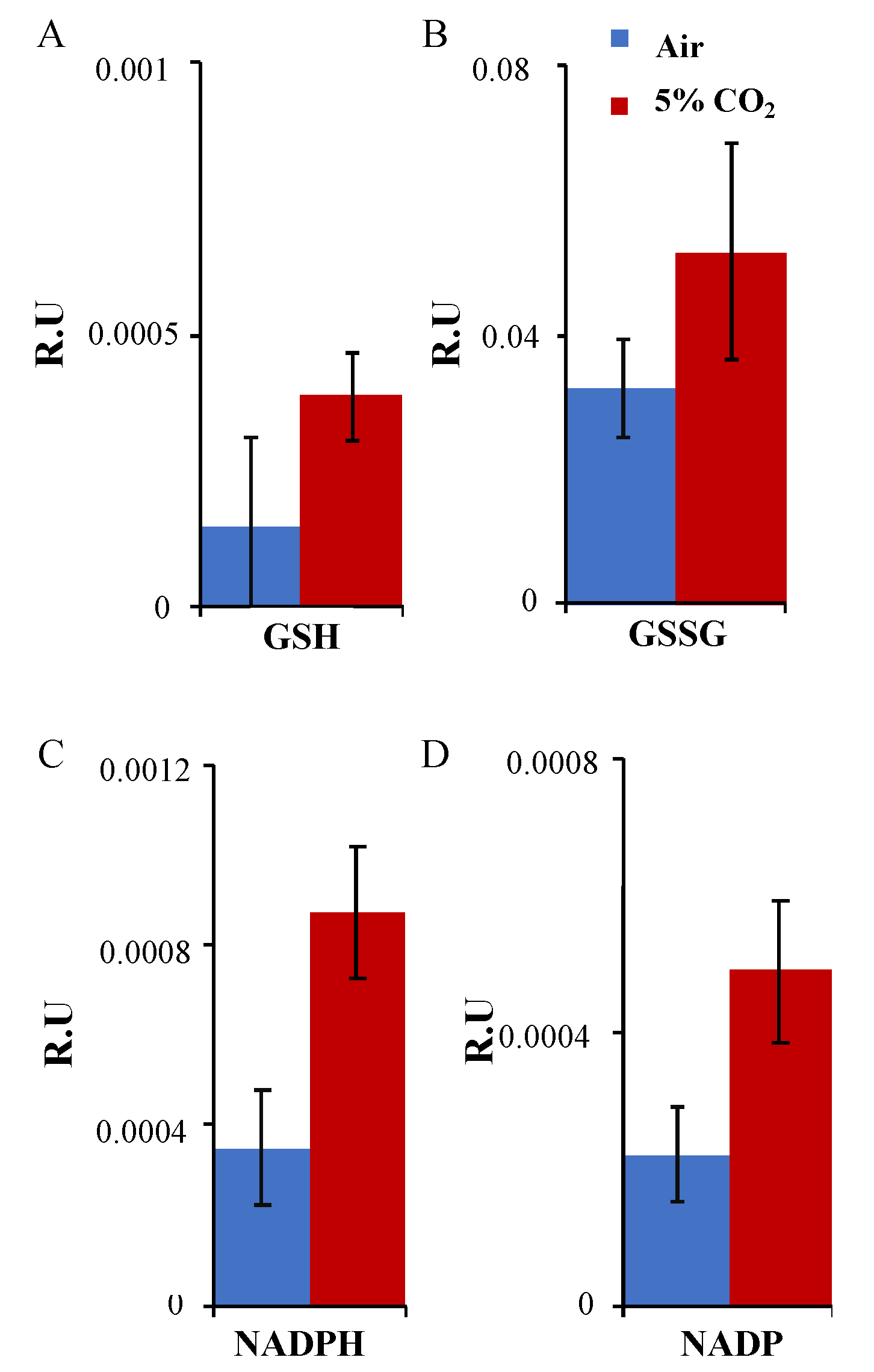CO2 Levels Modulate Carbon Utilization, Energy Levels and Inositol Polyphosphate Profile in Chlorella
Abstract
1. Introduction
2. Results
2.1. Chlorella Is Able to Grow under Different CO2 Conditions
2.2. Photosynthetic Activity Is Different between Chlorella Strains
2.3. Chlorella Strains Accumulate InsPs and Orthophosphate under 5% CO2 Concentration
2.4. Chlorella sorokinana and Chlorella vulgaris Differentially Distribute Carbon Storage under 5% CO2 Condition
2.5. Metabolic Adaptation in Chlorella sorokinana under Different CO2 Conditions
3. Discussion
4. Conclusions
5. Materials and Methods
5.1. Strains and Growth Conditions
5.2. Pulse–Amplitude Modulation Fluorometry
5.3. Metabolite Sample Preparation and Analysis
5.4. Inositol Polyphosphates Analysis and Orthophosphate Quantitation
5.5. Nile Red Staining and Fluorescence Microscopy
5.6. Starch Quantification
5.7. Statistical Analysis
Supplementary Materials
Author Contributions
Funding
Institutional Review Board Statement
Informed Consent Statement
Data Availability Statement
Acknowledgments
Conflicts of Interest
References
- Dong, X.; Qu, L.; Dong, G.; Legesse, T.G.; Akram, M.A.; Tong, Q.; Jiang, S.; Yan, Y.; Xin, X.; Deng, J.; et al. Mowing Mitigated the Sensitivity of Ecosystem Carbon Fluxes Responses to Heat Waves in a Eurasian Meadow Steppe. Sci. Total Environ. 2022, 853, 158610. [Google Scholar] [CrossRef] [PubMed]
- Klinthong, W.; Yang, Y.H.; Huang, C.H.; Tan, C.S. A Review: Microalgae and Their Applications in CO2 Capture and Renewable Energy. Aerosol Air Qual. Res. 2015, 15, 712–742. [Google Scholar] [CrossRef]
- Kumar, A.; Ergas, S.; Yuan, X.; Sahu, A.; Zhang, Q.; Dewulf, J.; Malcata, F.X.; van Langenhove, H. Enhanced CO2 Fixation and Biofuel Production via Microalgae: Recent Developments and Future Directions. Trends Biotechnol. 2010, 28, 371–380. [Google Scholar] [CrossRef] [PubMed]
- Gimpel, J.A.; Specht, E.A.; Georgianna, D.R.; Mayfield, S.P. Advances in Microalgae Engineering and Synthetic Biology Applications for Biofuel Production. Curr. Opin. Chem. Biol. 2013, 17, 489–495. [Google Scholar] [CrossRef] [PubMed]
- Maeda, Y.; Yoshino, T.; Matsunaga, T.; Matsumoto, M.; Tanaka, T. Marine Microalgae for Production of Biofuels and Chemicals. Curr. Opin. Biotechnol. 2018, 50, 111–120. [Google Scholar] [CrossRef]
- Gilmour, D.J. Microalgae for Biofuel Production. Adv. Appl. Microbiol. 2019, 109, 1–30. [Google Scholar] [CrossRef]
- Khan, M.I.; Shin, J.H.; Kim, J.D. The Promising Future of Microalgae: Current Status, Challenges, and Optimization of a Sustainable and Renewable Industry for Biofuels, Feed, and Other Products. Microb. Cell Fact. 2018, 17, 36. [Google Scholar] [CrossRef]
- Hu, J.; Liu, H.; Shukla, P.; Lin, W.; Luo, J. Nitrogen and Phosphorus Removals by the Agar–Immobilized Chlorella Sacchrarophila with Long–Term Preservation at Room Temperature. Chemosphere 2020, 251, 126406. [Google Scholar] [CrossRef]
- Kumari, K.; Samantaray, S.; Sahoo, D.; Tripathy, B.C. Nitrogen, Phosphorus and High CO2 Modulate Photosynthesis, Biomass and Lipid Production in the Green Alga Chlorella Vulgaris. Photosynth. Res. 2021, 148, 17–32. [Google Scholar] [CrossRef]
- Duarte, J.H.; de Morais, E.G.; Radmann, E.M.; Costa, J.A.V. Biological CO2 Mitigation from Coal Power Plant by Chlorella Fusca and Spirulina sp. Bioresour. Technol. 2017, 234, 472–475. [Google Scholar] [CrossRef]
- Zhang, J.; Perré, P. Gas Production Reveals the Metabolism of Immobilized Chlorella Vulgaris during Different Trophic Modes. Bioresour. Technol. 2020, 315, 123842. [Google Scholar] [CrossRef]
- Cordero, B.F.; Obraztsova, I.; Couso, I.; Leon, R.; Vargas, M.A.; Rodriguez, H. Enhancement of Lutein Production in Chlorella Sorokiniana (Chorophyta) by Improvement of Culture Conditions and Random Mutagenesis. Mar. Drugs 2011, 9, 1607–1624. [Google Scholar] [CrossRef] [PubMed]
- Markou, G.; Angelidaki, I.; Georgakakis, D. Microalgal Carbohydrates: An Overview of the Factors Influencing Carbohydrates Production, and of Main Bioconversion Technologies for Production of Biofuels. Appl. Microbiol. Biotechnol. 2012, 96, 631–645. [Google Scholar] [CrossRef] [PubMed]
- Brányiková, I.; Maršálková, B.; Doucha, J.; Brányik, T.; Bišová, K.; Zachleder, V.; Vítová, M. Microalgae–Novel Highly Efficient Starch Producers. Biotechnol. Bioeng. 2011, 108, 766–776. [Google Scholar] [CrossRef]
- Dragone, G.; Fernandes, B.D.; Abreu, A.P.; Vicente, A.A.; Teixeira, J.A. Nutrient Limitation as a Strategy for Increasing Starch Accumulation in Microalgae. Appl. Energy 2011, 88, 3331–3335. [Google Scholar] [CrossRef]
- Widjaja, A.; Chien, C.-C.; Ju, Y.-H. Study of Increasing Lipid Production from Fresh Water Microalgae Chlorella Vulgaris. J. Taiwan Inst. Chem. Eng. 2009, 40, 13–20. [Google Scholar] [CrossRef]
- Mukherjee, C.; Chowdhury, R.; Ray, K. Phosphorus Recycling from an Unexplored Source by Polyphosphate Accumulating Microalgae and Cyanobacteria—A Step to Phosphorus Security in Agriculture. Front. Microbiol. 2015, 6, 1421. [Google Scholar] [CrossRef]
- Couso, I.; Evans, B.S.; Li, J.; Liu, Y.; Ma, F.; Diamond, S.; Allen, D.K.; Umen, J.G. Synergism between Inositol Polyphosphates and TOR Kinase Signaling in Nutrient Sensing, Growth Control, and Lipid Metabolism in Chlamydomonas. Plant Cell 2016, 28, 2026–2042. [Google Scholar] [CrossRef]
- Tu-Sekine, B.; Kim, S.F. The Inositol Phosphate System—A Coordinator of Metabolic Adaptability. Int. J. Mol. Sci. 2022, 23, 6747. [Google Scholar] [CrossRef]
- Raboy, V. Low Phytic Acid Crops: Observations Based on Four Decades of Research. Plants 2020, 9, 140. [Google Scholar] [CrossRef]
- Crespo, J.L.; Díaz-Troya, S.; Florencio, F.J. Inhibition of Target of Rapamycin Signaling by Rapamycin in the Unicellular Green Alga Chlamydomonas Reinhardtii. Plant Physiol. 2005, 139, 1736–1749. [Google Scholar] [CrossRef] [PubMed]
- Couso, I.; Smythers, A.L.; Ford, M.M.; Umen, J.G.; Crespo, J.L.; Hicks, L.M. Inositol Polyphosphates and Target of Rapamycin Kinase Signalling Govern Photosystem II Protein Phosphorylation and Photosynthetic Function under Light Stress in Chlamydomonas. New Phytol. 2021, 232, 2011–2025. [Google Scholar] [CrossRef] [PubMed]
- Xie, D.; Ji, X.; Zhou, Y.; Dai, J.; He, Y.; Sun, H.; Guo, Z.; Yang, Y.; Zheng, X.; Chen, B. Chlorella Vulgaris Cultivation in Pilot–Scale to Treat Real Swine Wastewater and Mitigate Carbon Dioxide for Sustainable Biodiesel Production by Direct Enzymatic Transesterification. Bioresour. Technol. 2022, 349, 126886. [Google Scholar] [CrossRef]
- Marchello, A.E.; Oliveira, N.L.; Lombardi, A.T.; Polpo, A. An Investigation onto Cd Toxicity to Freshwater Microalga Chlorella Sorokiniana in Mixotrophy and Photoautotrophy: A Bayesian Approach. Chemosphere 2018, 211, 794–803. [Google Scholar] [CrossRef] [PubMed]
- de Melo, R.G.; de Andrade, A.F.; Bezerra, R.P.; Correia, D.S.; de Souza, V.C.; Brasileiro-Vidal, A.C.; Viana Marques, D.d.A.; Porto, A.L.F. Chlorella Vulgaris Mixotrophic Growth Enhanced Biomass Productivity and Reduced Toxicity from Agro–Industrial by–Products. Chemosphere 2018, 204, 344–350. [Google Scholar] [CrossRef]
- Liu, X.; Ying, K.; Chen, G.; Zhou, C.; Zhang, W.; Zhang, X.; Cai, Z.; Holmes, T.; Tao, Y. Growth of Chlorella Vulgaris and Nutrient Removal in the Wastewater in Response to Intermittent Carbon Dioxide. Chemosphere 2017, 186, 977–985. [Google Scholar] [CrossRef]
- Vojvodić, S.; Stanić, M.; Zechmann, B.; Dučić, T.; Žižić, M.; Dimitrijević, M.; Danilović Luković, J.; Milenković, M.R.; Pittman, J.K.; Spasojević, I. Mechanisms of Detoxification of High Copper Concentrations by the Microalga Chlorella Sorokiniana. Biochem. J. 2020, 477, 3729–3741. [Google Scholar] [CrossRef]
- Baker, N.R. Chlorophyll Fluorescence: A Probe of Photosynthesis In Vivo. Annu. Rev. Plant Biol. 2008, 59, 89–113. [Google Scholar] [CrossRef]
- Masojídek, J.; Torzillo, G.; Koblízek, M. Photosynthesis in Microalgae. In Handbook of Microalgal Culture: Applied Phycology and Biotechnology, 2nd ed.; Blackwell: Somerset County, NJ, USA, 2013; pp. 21–36. [Google Scholar] [CrossRef]
- Li-Beisson, Y.; Beisson, F.; Riekhof, W. Metabolism of Acyl-lipids in Chlamydomonas Reinhardtii. Plant J. 2015, 82, 504–522. [Google Scholar] [CrossRef]
- Goncalves, E.C.; Wilkie, A.C.; Kirst, M.; Rathinasabapathi, B. Metabolic Regulation of Triacylglycerol Accumulation in the Green Algae: Identification of Potential Targets for Engineering to Improve Oil Yield. Plant Biotechnol. J. 2016, 14, 1649–1660. [Google Scholar] [CrossRef]
- Foyer, C.H. Reactive Oxygen Species, Oxidative Signaling and the Regulation of Photosynthesis. Environ. Exp. Bot. 2018, 154, 134–142. [Google Scholar] [CrossRef] [PubMed]
- Foyer, C.H.; Noctor, G. Redox Homeostasis and Antioxidant Signaling: A Metabolic Interface between Stress Perception and Physiological Responses. Plant Cell 2005, 17, 1866–1875. [Google Scholar] [CrossRef] [PubMed]
- Hasanuzzaman, M.; Nahar, K.; Anee, T.I.; Fujita, M. Glutathione in Plants: Biosynthesis and Physiological Role in Environmental Stress Tolerance. Physiol. Mol. Biol. Plants 2017, 23, 249–268. [Google Scholar] [CrossRef] [PubMed]
- Liu, J.; Chen, F. Biology and Industrial Applications of Chlorella: Advances and Prospects. Adv. Biochem. Eng. Biotechnol. 2016, 153, 1–35. [Google Scholar] [CrossRef] [PubMed]
- Huss, V.A.R.; Frank, C.; Hartmann, E.C.; Hirmer, M.; Kloboucek, A.; Seidel, B.M.; Wenzeler, P.; Kessler, E. Biochemical Taxonomy and Molecular Phylogeny of the Genus Chlorella Sensu Lato (Chlorophyta). J. Phycol. 1999, 35, 587–598. [Google Scholar] [CrossRef]
- Krienitz, L.; Huss, V.A.R.; Bock, C. Chlorella: 125 Years of the Green Survivalist. Trends Plant Sci. 2015, 20, 67–69. [Google Scholar] [CrossRef]
- Leliaert, F.; Smith, D.R.; Moreau, H.; Herron, M.D.; Verbruggen, H.; Delwiche, C.F.; De Clerck, O. Phylogeny and Molecular Evolution of the Green Algae. CRC Crit. Rev. Plant Sci. 2012, 31, 1–46. [Google Scholar] [CrossRef]
- Huang, Y.-T.; Su, C.-P. High Lipid Content and Productivity of Microalgae Cultivating under Elevated Carbon Dioxide. Int. J. Environ. Sci. Technol. 2014, 11, 703–710. [Google Scholar] [CrossRef][Green Version]
- Sun, Z.; Chen, Y.-F.; Du, J. Elevated CO2 Improves Lipid Accumulation by Increasing Carbon Metabolism in Chlorella Sorokiniana. Plant Biotechnol. J. 2016, 14, 557–566. [Google Scholar] [CrossRef]
- Cecchin, M.; Paloschi, M.; Busnardo, G.; Cazzaniga, S.; Cuine, S.; Li-Beisson, Y.; Wobbe, L.; Ballottari, M. CO2 Supply Modulates Lipid Remodelling, Photosynthetic and Respiratory Activities in Chlorella Species. Plant. Cell Environ. 2021, 44, 2987–3001. [Google Scholar] [CrossRef]
- Yang, Y.; Gao, K. Effects of CO2 Concentrations on the Freshwater Microalgae, Chlamydomonas Reinhardtii, Chlorella Pyrenoidosa and Scenedesmus Obliquus (Chlorophyta). J. Appl. Phycol. Vol. 2003, 15, 379–389. [Google Scholar] [CrossRef]
- Ueno, Y.; Shimakawa, G.; Aikawa, S.; Miyake, C.; Akimoto, S. Photoprotection Mechanisms under Different CO2 Regimes during Photosynthesis in a Green Alga Chlorella Variabilis. Photosynth. Res. 2020, 144, 397–407. [Google Scholar] [CrossRef]
- Siaut, M.; Cuiné, S.; Cagnon, C.; Fessler, B.; Nguyen, M.; Carrier, P.; Beyly, A.; Beisson, F.; Triantaphylidès, C.; Li-Beisson, Y.; et al. Oil Accumulation in the Model Green Alga Chlamydomonas Reinhardtii: Characterization, Variability between Common Laboratory Strains and Relationship with Starch Reserves. BMC Biotechnol. 2011, 11, 7. [Google Scholar] [CrossRef] [PubMed]
- Ran, W.; Wang, H.; Liu, Y.; Qi, M.; Xiang, Q.; Yao, C.; Zhang, Y.; Lan, X. Storage of Starch and Lipids in Microalgae: Biosynthesis and Manipulation by Nutrients. Bioresour. Technol. 2019, 291, 121894. [Google Scholar] [CrossRef]
- Li, J.; Pan, K.; Tang, X.; Li, Y.; Zhu, B.; Zhao, Y. The Molecular Mechanisms of Chlorella sp. Responding to High CO2: A Study Based on Comparative Transcriptome Analysis between Strains with High- and Low-CO2 Tolerance. Sci. Total Environ. 2021, 763, 144185. [Google Scholar] [CrossRef]
- Hollis, L.; Ivanov, A.G.; Hüner, N.P.A. Chlorella Vulgaris Integrates Photoperiod and Chloroplast Redox Signals in Response to Growth at High Light. Planta 2019, 249, 1189–1205. [Google Scholar] [CrossRef]
- Allen, M.B.; Arnon, D.I. Studies on Nitrogen-Fixing Blue-Green Algae. I. Growth and Nitrogen Fixation by Anabaena Cylindrica Lemm. Plant Physiol. 1955, 30, 366–372. [Google Scholar] [CrossRef]
- Guillard, R.R.L.; Kilham, P.; Jackson, T.A. Kinetics of silicon-limited growth in the marine diatom Thalassiosira pseudonana hasle and heimdal (=cyclotella nana hustedt) 2. J. Phycol. 1973, 9, 233–237. [Google Scholar] [CrossRef]
- Kramer, D.M.; Johnson, G.; Kiirats, O.; Edwards, G.E. New Uorescence Parameters for the Determination of Q. Biol. Chem. 2004, 79, 209–218. [Google Scholar]
- Klughammer, C.; Schreiber, U. Complementary PS II Quantum Yields Calculated from Simple Fluorescence Parameters Measured by PAM Fluorometry and the Saturation Pulse Method. PAM Appl. Notes 2008, 1, 27–35. [Google Scholar]
- McCloskey, D.; Ubhi, B.K.S. Quantitative and Qualitative Metabolomics for the Investigation of the Intracellular Matabolism. Sciex Tech. Note 2014, 1, 1–11. [Google Scholar]
- Wang, Z.T.; Ullrich, N.; Joo, S.; Waffenschmidt, S.; Goodenough, U. Algal Lipid Bodies: Stress Induction, Purification, and Biochemical Characterization in Wild-Type and Starchless Chlamydomonas Reinhardtii. Eukaryot. Cell 2009, 8, 1856–1868. [Google Scholar] [CrossRef] [PubMed]





| C. sorokiniana | C. vulgaris | |||
|---|---|---|---|---|
| [CO2] | μ (h−1) | Fv/Fm | μ (h−1) | Fv/Fm |
| Air | 0.06 ± 0.003 | 0.81 ± 0.03 | 0.05 ± 0.001 | 0.79 ± 0.03 |
| 1% | 0.06 ± 0.002 | 0.81 ± 0.05 | 0.05 ± 0.002 | 0.85 ± 0.02 |
| 3% | 0.06 ± 0.002 | 0.83 ± 0.04 | 0.06 ± 0.003 | 0.85 ± 0.02 |
| 5% | 0.06 ± 0.005 | 0.81 ± 0.02 | 0.06 ± 0.002 | 0.86 ± 0.05 |
Disclaimer/Publisher’s Note: The statements, opinions and data contained in all publications are solely those of the individual author(s) and contributor(s) and not of MDPI and/or the editor(s). MDPI and/or the editor(s) disclaim responsibility for any injury to people or property resulting from any ideas, methods, instructions or products referred to in the content. |
© 2022 by the authors. Licensee MDPI, Basel, Switzerland. This article is an open access article distributed under the terms and conditions of the Creative Commons Attribution (CC BY) license (https://creativecommons.org/licenses/by/4.0/).
Share and Cite
Morales-Pineda, M.; García-Gómez, M.E.; Bedera-García, R.; García-González, M.; Couso, I. CO2 Levels Modulate Carbon Utilization, Energy Levels and Inositol Polyphosphate Profile in Chlorella. Plants 2023, 12, 129. https://doi.org/10.3390/plants12010129
Morales-Pineda M, García-Gómez ME, Bedera-García R, García-González M, Couso I. CO2 Levels Modulate Carbon Utilization, Energy Levels and Inositol Polyphosphate Profile in Chlorella. Plants. 2023; 12(1):129. https://doi.org/10.3390/plants12010129
Chicago/Turabian StyleMorales-Pineda, María, Maria Elena García-Gómez, Rodrigo Bedera-García, Mercedes García-González, and Inmaculada Couso. 2023. "CO2 Levels Modulate Carbon Utilization, Energy Levels and Inositol Polyphosphate Profile in Chlorella" Plants 12, no. 1: 129. https://doi.org/10.3390/plants12010129
APA StyleMorales-Pineda, M., García-Gómez, M. E., Bedera-García, R., García-González, M., & Couso, I. (2023). CO2 Levels Modulate Carbon Utilization, Energy Levels and Inositol Polyphosphate Profile in Chlorella. Plants, 12(1), 129. https://doi.org/10.3390/plants12010129





